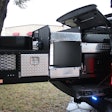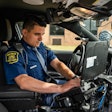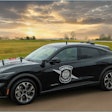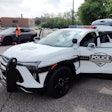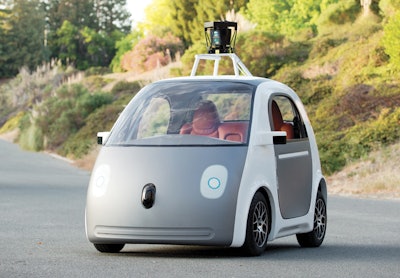 Photo: Google
Photo: Google
Imagine it's the year 2020. Prior to hitting the street, Officer Megan Starr of the San Rafael (Calif.) Police Department inspects her 2020 model year police cruiser. She gets into the driver's seat, which recognizes her by retina scan, and it immediately moves to the position she prefers. Officer Starr logs on via voice request to the department CAD system and "tells" the vehicle to patrol the downtown area using random patrol "Henry 1."
The vehicle leaves the rear lot of the police department. As the car drives itself around the downtown area, Starr reads the briefing log to see what happened in the previous 12 hours. She thinks about the officers who used to have to drive themselves while looking at the CAD screen, operating the lights and siren, and talking on the radio while trying to find a suspect who might be running away. The life of a police officer has dramatically changed with the autonomous vehicle, she thinks. It's allowed the police to focus on crime fighting rather than on maneuvering their cruisers.
Although it might seem unlikely to someone who has not studied advances in transportation, Officer Starr's shift is an example of what law enforcement could be in the near future when the autonomous vehicle takes over as the "driver." We will look at where the development of these self-driving cars is at present, the legal implications, and how driverless vehicles could transform police organizations as a result.
How an Autonomous Vehicle Drives
The autonomous vehicle that Google has been testing on the roads of California and Nevada has received a fair amount of attention as of late. And the company has now announced plans for a new fleet of subcompact vehicles without a steering wheel to debut on public streets this year. This driverless car will feature software that can program a route and a button to start and stop the car. Everything else is supposed to be automated and rely on sensors for adjustments during the drive. Other companies have stated that by 2020 they intend to be ready to sell driverless vehicles. In fact, many people don't realize that these seemingly futuristic vehicles, also known as "smart" cars, use technologies already installed in vehicles for sale today.
If you go to a car dealership right now, you can test drive a car with an upgrade like the collision avoidance system. According to America Online Techsplanation, a collision avoidance system starts with what's called adaptive cruise control. It uses sensors to determine when to automatically slow, stop, or take evasive maneuvers if need be.
If your car is getting too close to another car too quickly, the system will apply brake pressure more quickly than a human could. If the computers and sensors determine that a crash is unavoidable, they also work to tighten seat belts, adjust headrests, or close the power windows and sunroof to make the car safer during a collision. Clearly we're already allowing vehicles to act for us. It's only a matter of time before we leave more of the driving duties to computers.
Expanding upon the collision avoidance system, autonomous vehicles are designed to use similar technology to communicate with other vehicles, traffic lights, and roadway signs. This allows them to drive closer to one another on the freeway, fitting more vehicles on the road at once. This orderly procession will also result in vehicles maintaining a consistent speed. According to Volkswagen of America and Google, this will allow traffic to flow smoothly and vehicle accidents overall could be a thing of the past.
Better Living through Technology
One major upside of these technological advances is smart cars could dramatically reduce the incidence of the most serious traffic collisions and therefore reduce injuries and deaths. If the vehicle is in charge, the car's occupants would not have the ability to run a red light, make an unsafe lane change, or violate other vehicle codes that commonly cause injury and property damage.
Vehicles able to link and travel smartly could also affect the way we live our lives. People who live in urban areas often plan their lives around traffic patterns; our largest cities are commonly paralyzed by traffic that takes hours to navigate through. The predictability of smart travel could remove the uncertainty of commute time, allowing people to spend more time at work and at home. Many workers could also live farther away from work if need be without the extra time on the road, and generally maximize the quality of their lives by removing a significant impediment to their daily tasks.
As great as the future appears to be when it comes to autonomous vehicles, when you look at this technology through a law enforcement lens there are many questions to be answered before it enters the mainstream.
Goodbye to Licenses
By mid-2015, California's Department of Motor Vehicles will have developed regulations for public use of driverless cars. This should allow Google to sell its newly developed cars and put more of them on the streets. But this is only the beginning of laws we can expect to change in response to autonomous vehicles.
Government agencies typically lag behind the private sector when it comes to updating to newer technology. Anyone who has worked in law enforcement knows that budgeting cycles and public bid processes slow down purchases involving the use of public funds. Unfortunately, if this same stance is taken when it comes to purchasing autonomous vehicles, public safety could be in for trouble. A new approach to handling car technology needs to be spearheaded by the law enforcement community from the start.
One of the first laws that needs to be examined is the most basic of all: "Do you need a driver's license to drive an autonomous vehicle?" Your instinct may be to say "yes," but once it's determined the technology is reliable, why do you need to know how to drive a car if it drives itself? Google notes that as of August 7, 2012, the company's driverless smart vehicles already had more than 300,000 miles logged without a single accident under computer control.
All of this driving occurred on freeways, which are simpler to navigate than city streets, and more works needs to be done to take into account complicated situations such as four-way stops and roundabouts. But 300,000 miles is a significant amount, and a promising start. And with its new fleet of two-seater driverless vehicles, Google intends to perfect its technology for city driving. If Google can find a way to ensure that city driving by autonomous cars is safe and reliable, will it be enough to change our culture?
Perhaps prospective smart car owners will attend some kind of a computer class instead of the practical drivers training we're accustomed to that allows us to interface with our vehicles at a young age. You only need to walk around for a few minutes to see a 5-year-old playing with an iPhone and realize these young children could probably operate an autonomous vehicle just fine.
Once the question about driver's licenses and drivers training is overcome, numerous other laws will have to be assessed and adjusted. Laws that relate to distracted driving could be rendered moot. Recently, laws have been enacted to stop people talking on their cellular phones and texting while driving. Autonomous cars could make these newer laws obsolete, as well as laws prohibiting any other activity that would normally distract or impair people while driving.
No More DUIs
For example, laws about drinking alcohol and driving a car will be challenged, and this affects law enforcement greatly. If you are not required to be in control of your car, should it be illegal to drink and drive? Since the autonomous vehicle could turn into a driverless limousine, would advocacy groups such as Mothers Against Drunk Driving urge its adoption?
In one way, a driverless car accomplishes the goal of greatly reducing if not eliminating the fatalities caused by drunk driving. On the other hand, it could lead to people drinking even more when they go out without the fear of getting arrested for drunk driving. If this is the case, the domino effect on law enforcement operations and funding could have far-reaching consequences.
The Office of Traffic Safety provides numerous funding opportunities for agencies to enforce the laws related to drinking and driving. DUI checkpoints and roving patrols target people who drink and drive. If the autonomous vehicle progresses into the mainstream, this will no doubt change.
Not only will injuries and fatalities related to drinking and driving plummet, but the need for the legislature to commit a large amount of funds to preventing drunk driving accidents would not be necessary. This could allow funds to be used for other important public purposes (not necessarily related to policing), including research into the next piece of technology that could continue to enhance public safety. In addition to changes in the law, there may also be dramatic changes to the structure of law enforcement as we know it.
Losing Traffic Stops
With reduced funding and greatly reduced injuries and fatalities, an additional unintended consequence of smart cars may be significantly fewer law enforcement personnel assigned to traffic enforcement.
Perhaps such officers could be reassigned to a variety of task forces or other law enforcement-related duties. Alternatively, these positions could be eliminated for cost savings. Instead, non-sworn employees would patrol the highways and freeways and be available to provide assistance to a motorist in the unlikely event that his or her vehicle breaks down.
These sweeping changes could have far-reaching effects from which the structure, purpose, and function of field policing will drastically change. The most impactful effect would be losing the traffic stop as a means of identifying offenders.
Anyone in law enforcement knows that proactive police work is the backbone of any good agency. The ability to stop a crime before it happens is the perfect storm in law enforcement. Many serious criminal cases are solved subsequent to stopping a vehicle for violating a section of the state's vehicle code. These stops, for infractions ranging from running red lights to equipment violations, will dramatically drop. Additionally, pretext stops are conducted in narcotics and intelligence investigations as a means to identify persons suspected of criminal activity.
The autonomous vehicle has the potential to change all of this, and change forever the manner in which police detect and investigate a wide range of crimes. The impact on law enforcement's ability to combat crime will have to be measured over a period of time.
And let's not forget how this would affect fines revenue. If officers aren't stopping drivers for traffic violations, no one will be paying speeding tickets, for example. Where will the funding for public safety programs come from? A portion of the fines collected by courts go to prosecutorial efforts. Some of the revenue pays for law enforcement programs and training. All of these functions will be significantly impacted by the loss of their traditional funding sources.
These issues are by no means any reason to oppose the rise of the autonomous vehicle; the possibility to reduce the number of people who die in vehicle-related deaths every year is too great to not pursue this technology. It is just a reminder to the law enforcement community that change occurs, and unless they are looking forward, an invention such as this could affect the field greatly if no one has prepared for it.
Get Ready
With all the changes slated to take place in the vehicles of the near future, what should law enforcement do to prepare for the impending change? First of all, realize that it's not the end of the world and you'll get used to it.
You can no doubt point to at least one major change in policing during your career and recall the difference in how it was received before and after implementation. It wasn't that long ago that officers got handheld radios for their belts, replaced revolvers with semi-automatic handguns, and got computers in their cars. Smart cars will soon join that group as another generational advance of importance to law enforcement.
All of the above mentioned changes eventually proved to be groundbreaking in time, but initially there were many skeptics who either didn't think the technology could be reliable, or who preferred to do things the old way. No matter what the reason, these technologies progressed and eventually became the industry standard. If we told officers 10 years ago they would have handheld computers (smartphones) in their pockets while they did their job, most would have either not believed it or thought it wouldn't be useful. Just as happened with the advent of portable radios and soft body armor, once the new ways become the norm, going back to the past becomes unthinkable.
The first hurdle to the acceptance of self-driving cars by law enforcement is educating officers as to what this technology is and what it isn't. Pointing out that elements of autonomous vehicle functions are on the roads today helps people understand that these ideas are no longer confined to Hollywood movies. The more officers who can convince their agencies to address these cars' effect on our profession now the better.
Law enforcement needs to work with the legislature to make recommendations regarding law and policy well ahead of the emergence of the consumer-useful autonomous car. Since it has already been made legal by the legislatures in California and Nevada, we could already be a step behind. It is going to take vibrant, visionary leaders to prepare the law enforcement field for its biggest change in years.
If you look back to my example of Officer Starr's fictional shift, you can see how helpful the autonomous vehicle could be as a patrol car for law enforcement officers. It freed the officer to look around more, take in more information, vary her patrol techniques, and allow serious multitasking while driving. It doesn't take much to envision how this could enhance officer safety.
There is also vast potential to reduce liability as well as to protect the lives of the police and the people they serve. An autonomous cruiser will communicate with the other vehicles on the road, as well as communicate with traffic signals to allow you to get to a serious call for service more efficiently and safely than ever before. Finally, the officer patrolling in an autonomous vehicle has the ability to focus on in-progress or quality-of-life crimes without worrying about traffic enforcement.
The patrol shift of the near future, with the help of the autonomous vehicle, could change the culture of law enforcement very quickly. I was reminded of how close this technology is to becoming common when driving to work the other day.
I saw a vehicle in the number two lane on highway 101 in San Rafael. As I got closer, I saw that it was the "Google" car driving itself down the road with a human in the driver's seat, but she was not touching the wheel. Someday that will be all of us, and that day is coming very soon.
Dan Fink is a lieutenant with the San Rafael (Calif.) Police Department.









